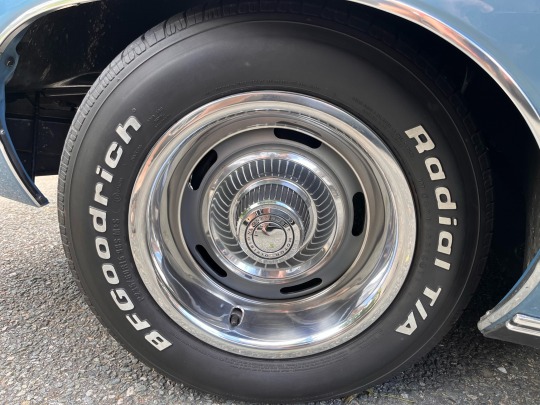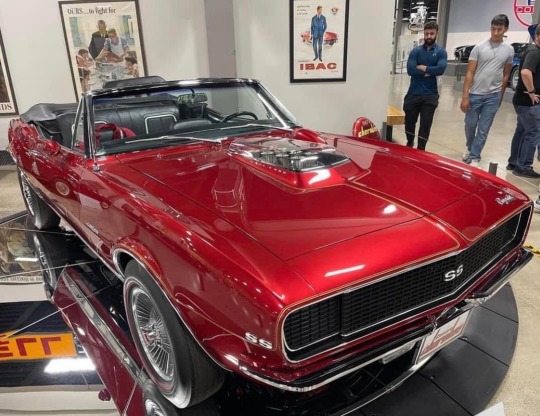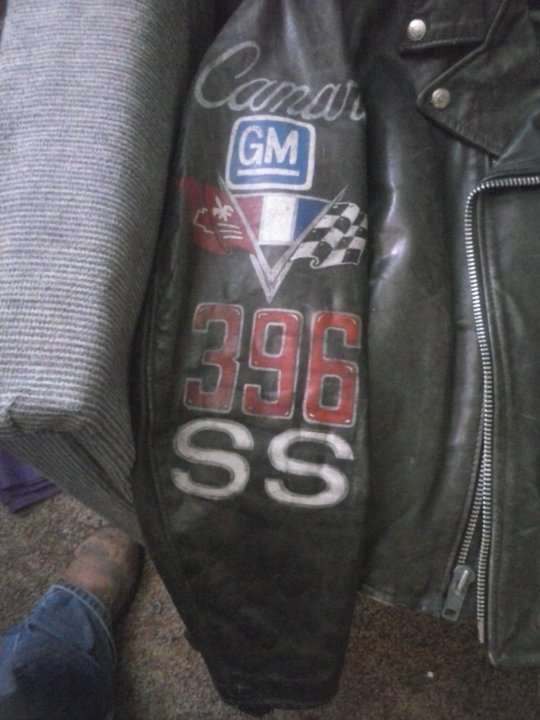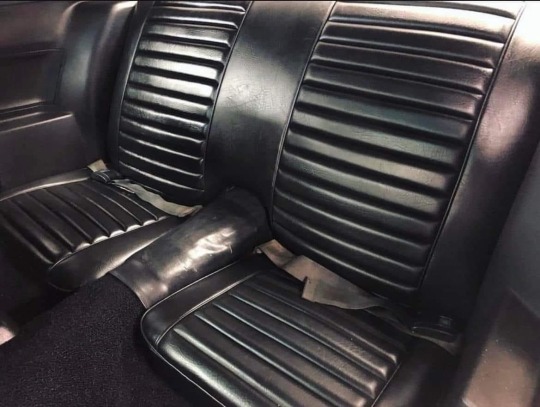#396 Big Block
Explore tagged Tumblr posts
Text

1969 Chevrolet Chevelle Malibu - 396 Big Block
#Chevrolet Chevelle Malibu#chevrolet chevelle#Chevrolet#Malibu#chevelle#car#cars#muscle car#american muscle#396 Big Block#396
477 notes
·
View notes
Text

#1969 chevelle ss#super sport#gm#chevrolet#Cragar's#396#big block#vinyl roof#b.f goodrich#dusk blue#black interior
411 notes
·
View notes
Text

1968 RS 396 Camaro - My kind of woman
17 notes
·
View notes
Text









1967 Chevy Impala SS with a 396 Turbo-Jet L78 big block engine (probably making 375HP). August 2024.
#yzshot#chevy#chevrolet#chevy impala#impala ss#1960s#1960s cars#muscle car#classic car#classics#classic cars#detroit#general motors#gm#usa#american cars#big block#v8#turbojet
93 notes
·
View notes
Text
youtube
"Thirteen" is a song by American rock band Big Star. Rolling Stone describes it "one of rock's most beautiful celebrations of adolescence", and rated it #396 on their list of the 500 greatest songs of all time. It was written by Alex Chilton and Chris Bell.
The name of the album was #1 Record, which was bitterly ironic, as it ended up selling under 10,000 copies upon its initial release in 1972 (the name of the band also proved to be an unfortunate misnomer, because outside of critics and other musicians, they remained virtually anonymous during their brief time together).
Bell and Chilton wanted to emulate the Lennon/McCartney formula as much as they could, so they shared credit on many of their songs even though there was in fact little writing collaboration between the two. “Thirteen" was in fact entirely Chilton’s creation, and he also delivers the aching vocal that vacillates between hope and heartache and that many cover versions have tried to emulate but never quite matched.
The yearning acoustic ballad focuses on an age that is somewhat underrepresented in pop and rock music. Chilton found that bittersweet spot when innocence still lingers but more complicated emotions start to work their way into the picture.
Over tender guitars, he begins with a question that thirteen-year-old boys have been asking thirteen-year-old girls for generations: “Won’t you let me walk you home from school?” “Won’t you let me meet you at the pool?” he follows, again treading lightly so as not to scare her away. He eventually suggests a date at the dance on Friday; “And I’ll take you,” Chilton delicately sings, as if anything more forceful than a gentle plea will destroy his chances.
In the second verse, the narrator for the first time reveals an obstacle blocking the path to this girl for whom he is clearly falling hard: “Won’t you tell your Dad get off my back?” he asks her. His response to the doubting father is brilliant: “Tell him what we said about ‘Paint It Black.’” By drawing a parallel between his own musical tastes and that of the father, he’s hoping to show that he’ s not just some punk kid with bad intentions.
The final verse finds him struggling as she remains seemingly unknowable (“Won’t you tell me what you’re thinking of?”) resulting in his sweet but awkward follow up (“Would you be an outlaw for my love?”) His final lines redeem him in terms of his integrity and honor, even as they suggest that he’ s losing his opportunity with her in the process: “If it’ s no then I can go/ I won’ t make you.” The final “Ooo-hoo” that Chilton utters is a real killer, tinged as it is with the sting of implied refusal.
Over the decades there have been some fine cover versions of this classic, with brilliant and diverse artists like Garbage, Wilco, and Elliott Smith taking their turns, among many others. But they’d likely all agree they were playing for second behind Chilton’s one-of-a-kind, haunting performance. “Thirteen” is as good as it gets for those looking to relive that moment when life is still rife with possibilities but love seems stubbornly impossible.
Music critic Simon Robinson rates it as Big Star's best song and one of the most important of 1972, praising the "catchy melody and jangly guitars that perfectly capture the carefree and optimistic spirit of youth" and the "simple yet poignant" lyrics that evoke the "experience of teenage romance and heartbreak."
65 notes
·
View notes
Text









Camaro Cherokee concept car. 67 RS/SS with an L-78 Gen IV 396 big block under the hood. 8 Weber downdraft carbs top it off. Aztec Gold Metallic base coat finished off with Candy Apple Red.
39 notes
·
View notes
Text








Chevrolet Chevelle 396 Super Sport 1968 - 396 Big Block 4 Speed Manual. - source Pacific Classics.
64 notes
·
View notes
Text

sleeve I painted on my leather Jacket I owned a 1972 Camaro that I put a 1969 396 big block in.
4 notes
·
View notes
Text
1966 Chevrolet Chevelle 396
History of the 1966 Chevrolet Chevelle 396
The 1966 Chevrolet Chevelle 396 marked a turning point in Chevrolet’s muscle car history.
Originally introduced in 1964 as a response to the Pontiac GTO, the Chevelle evolved into a true muscle car contender by 1966 with the introduction of the SS 396 as a standalone model. This year was significant because Chevrolet fully committed to the big-block V8 as the centerpiece of its Super Sport (SS) lineup.
Chevrolet designed the 1966 Chevelle SS 396 to appeal to drivers who wanted a high-performance machine with aggressive styling and brute force. The car combined raw power with everyday drivability, making it one of the most sought-after muscle cars of the era. The Chevelle name would go on to become legendary, with the 396 engine playing a crucial role in that legacy.

Design Features
The 1966 Chevelle SS 396 introduced a new look that was more aggressive and defined than previous models. Some standout design elements included:
Coke-Bottle Styling: The 1966 Chevelle featured a more sculpted body with flared fenders and a sleeker, fastback-style roofline.
Bold Front End: A wider grille with horizontal chrome bars, stacked headlights, and an “SS 396” badge made the car instantly recognizable.
Domed Hood: This subtle but muscular design cue hinted at the power lurking beneath.
"Super Sport" Badging: Exclusive to the SS 396, these badges let everyone know this wasn’t just any Chevelle.
Bucket Seats & Center Console (Optional): Unlike some stripped-down muscle cars, the SS 396 could be equipped with a sporty yet comfortable interior, featuring optional bucket seats and a center console with a floor-mounted shifter.

Engine Performance
The heart of the 1966 Chevelle SS 396 was its big-block V8, available in three different power levels:
Standard 396 V8:
Horsepower: 325 hp
Torque: 410 lb-ft
0-60 mph: ~7.0 seconds
Quarter-Mile: ~14.7 seconds
L34 396 V8 (Mid-Level Option):
Horsepower: 360 hp
Torque: 420 lb-ft
0-60 mph: ~6.5 seconds
Quarter-Mile: ~14.3 seconds
L78 396 V8 (High-Performance Version):
Horsepower: 375 hp
Torque: 415 lb-ft
0-60 mph: ~6.0 seconds
Quarter-Mile: ~13.8 seconds
The L78 version was the most powerful and featured high-compression cylinder heads, a hotter camshaft, and a Holley 780 CFM carburetor. This made it one of the fastest muscle cars available in 1966.
Why the 1966 Chevelle SS 396 Stood Out
The 1966 Chevelle SS 396 was an instant classic because it offered the perfect balance of power, style, and affordability. Here’s why it stood out:
Big-Block Power for the Masses: Unlike higher-priced rivals, the Chevelle SS 396 provided incredible performance at a reasonable price.
Striking Styling: The new Coke-bottle design gave it a more aggressive and aerodynamic look.
Versatility: It could be ordered as a no-frills street brawler or a well-equipped cruiser with power steering, air conditioning, and a refined interior.
Chevrolet’s Reputation: Chevy’s small-block V8s were already legendary, and the introduction of the 396 big-block solidified the brand’s place in the muscle car world.
Race-Ready Performance: The high-compression L78 version turned the Chevelle into a drag strip monster, outperforming many of its competitors.
Current Value by Grade
The value of a 1966 Chevelle SS 396 varies significantly based on condition, originality, and whether it has the desirable L78 engine option.
Concours Condition (Fully Restored, Showroom Quality): $90,000 – $140,000
Excellent Condition (Well-Restored, Show Quality): $60,000 – $90,000
Good Condition (Driver-Quality, Some Restorations): $40,000 – $60,000
Fair Condition (Needs Restoration, Some Wear and Tear): $25,000 – $40,000
Project Car (Non-Running or Significant Restoration Needed): $15,000 – $25,000
L78-equipped models are the most valuable, often commanding a premium due to their rarity and performance. Numbers-matching SS 396s with factory documentation can also fetch higher prices at auctions.

The 1966 Chevrolet Chevelle SS 396 was a game-changer in the muscle car world. It proved that Chevrolet could go toe-to-toe with the best performance cars of the era while still offering a refined and stylish ride. Today, it remains one of the most sought-after classic muscle cars, cherished for its bold design, legendary 396 engine, and role in defining the golden age of American muscle.

66 Chevelle SS 396
914 notes
·
View notes
Text

1969 Chevy Camaro
The 1969 Chevy Camaro stands as one of the most iconic muscle cars ever produced. Its sharp styling, powerful engine options, and overall performance have cemented its legendary status.
* Distinctive Styling: The 1969 Camaro featured a redesigned body with sharper lines, a new grille, and updated taillights. The overall look was more aggressive and muscular than previous years.
* Performance Variants: Chevrolet offered a wide range of engines, from the base six-cylinder to high-performance V8s. The SS package, in particular, was highly sought after for its powerful engines and performance-oriented features.
* RS Appearance Package: The RS package added cosmetic enhancements like hidden headlights, black-out grille, and special badging, giving the car a sportier look.
* Z/28: This performance-focused model was designed for racing and featured a high-revving small-block V8 engine, along with other performance upgrades.
The 1969 Camaro offered a variety of engines to suit different preferences and budgets:
* Base engines: Inline-6 and small-block V8 options
* Performance-oriented engines: Larger V8s, including the legendary 396 cubic inch and 427 cubic inch big-blocks
The SS package elevated the Camaro to a higher level of performance. It typically included larger V8 engines, performance-tuned suspension, and visual cues to distinguish it from base models..
158 notes
·
View notes
Text

452 notes
·
View notes
Video
youtube
The Shocking Truth behind Chevrolet Banned 396 Big Block Engine!
0 notes
Text
How Fast is the 2025 Dodge Charger Daytona 670hp Test Drive! https://www.youtube.com/watch?v=jIW5vC-3onU
youtube
These cars are big they know that about it this is a very big car it's long the wheelbase is big it's got the wheelbase of a modern full-size sedan it's about a half an inch shorter and has a back seat it saves a lot of money if you don't save the take the transmission out and the transmission heavy duty if it's a standard it will fit they made a lot of those and it's for a direct connection
Yeah I'm saying this room for an indirect connection even with automatic transmission because it mounts on the bottom of the engine you've done it before
The engine's going to be close to you know something had a big block what we're talking about this car they usually had a big block he says you don't get rid of the engine you rebuild it and you rebuild the transmission lot of them have been rebuilt yesterday a year ago 20 years ago 30 years ago and still run very nicely you don't even separate the transmission but you need a new transaxle definitely have to do the rear end suspension transaxle and axles or you're not going to go over 450 miles an hour without bouncing off the road.
Trump is speaking as a leader in a different country it said silently if you get killed in this car it's your fault and our son says if you get killed in this car the way I suggest to build it and the front end you can put a fairing on and you don't have to change much else but he does suggest shopping it you can put a cage in and move the motor make it rear independent suspension but anyways he said if you make this car and get killed in it it's your fault and our son says you'll be a hero and it's sort of knew he would say that because he says it all the time and it's true if you die in it you'll be a hero because you're going to get where you want to get to you're going to get away from me those guys 396 hemi with a street blower with independent suspension the new transaxle is going to go about 780 mph very safely 12 to 1300 mph and you're going to lose all your hair from fright then you put a wing on the front and you can go a thousand miles an hour safely like speed racer looks oddly Indian and so does Sasha I mean. Not duh lol these guys are moving out and they're doing it
Thor Freya
He says people are into it because they want to mess up our stuff and we like the low numbers and we want to keep them that's what they're up to and low numbers are in the millions
Olympus
Ohh you craps
Hera
Zues
0 notes
Text
Chevy Chevelle - Iconic Muscle Car of its Era

One of the most versatile muscle cars of its era, the Chevy Chevelle first came off the production line in September 1963, introduced at a Chicago press conference. Built on an A-body platform, the Chevelle shared the same underlying frame as the Oldsmobile Cutlass, Pontiac Tempest, and Buick Skylark. Its niche was between the large Impala and compact Chevy II/Nova, and its nearest competitor at launch was the Ford Fairlane. The popular mid-size sold 338,286 units in its first year and remained in production until 1977.
Introduced as a 220-horsepower 283cid, the Chevelle was initially available as a two-door hardtop, the Sports Coupe, or a convertible. A smaller number of four-door sedans and two or four-door station wagon models also made it to showroom floors. One hallmark was that it returned the 115-inch wheelbase of 1955 to 1957 Chevys. This created a smooth ride that backseat passengers appreciated, making it a popular family vehicle. By the end of 1964, the Chevelle was available with a top-line 300 horsepower 327cid engine that solidified it in the performance category.
By 1965, Chevy offered a performance 350hp L79 engine on its Super Sport (SS) trim model. Innovations included vinyl bucket seats with a floor console, a four-gauge cluster, and an optional dash-mounted tachometer that measured revolutions per minute.
In 1965, Chevrolet upped the ante, introducing the Chevy Malibu SS 396 Z16. The Z16 replaced the small-block engine of previous SS models with a big-block V8 engine known as the 396 (or L37). This delivered a full-throated 375 horsepower and is seen by many as the start of the classic muscle car era. The Z16 is also one of the most sought-after models by vintage collectors, as only 201 of the new trim was manufactured in its inaugural year.
The popularity of the higher-performance Super Sport packages on the baseline Chevelle was such that in 1966, Chevrolet made SS its model, which featured a 396 engine and horsepower options between 325 and 375. This more limited version of the first-generation Chevelle, the SS396 series, lasted through 1968.
Spanning 1968 to 1972, the second generation of the Chevelle relegated Super Sport to an engine package again and represented a radical redesign of the vehicle. The 396 cubic inch, 375hp engine remained the top-of-line option. Aesthetically, the taillights were bigger, and the back of the vehicle was shorter and curvier. With a cut wheelbase, the second-generation Chevelle also featured a noticeably longer hood.
The 1970 Chevelle LS6 introduced the iconic twin racing-stripe front hood option, which is familiar from car chase scenes in movies and TV series of the era. Its taillights were bumper-mounted, and with a 450 horsepower 454 block, it had one of the most powerful engines of the era. The highly collected model only lasted a single year: already, United States regulations were on the horizon that would make better mileage vehicles a must, and in 1971, the vehicle returned to a small-block 350 engine.
The mid-1970s oil crisis and further fuel economy regulations stripped the Chevelle line of its power and luster. By 1977, the Chevrolet Chevelle and Malibu series had only 145 horsepower, a far cry from their muscle car heydays. The following year, the Chevelle was folded into the Malibu brand as Chevy streamlined operations.
0 notes
Link
*1969 CHEVROLET CHEVELLE CONVERT*RESTO MOD*396 BIG BLOCK* FINANCING*
0 notes
Text










1970 Camaro SS in Medium shade Metallic Blue, with Light Blue Metallic ghost stripes, full chrome front bumper, rear spoiler & factory wheels. It's powered by an L34 396 big block & Muncie 4-spd manual, 12 bolt posi rear end. Black interior w/factory air, factory in-dash tach and a Hurst shifter.
9 notes
·
View notes